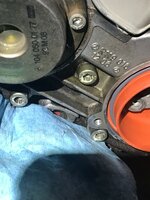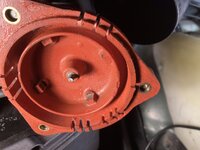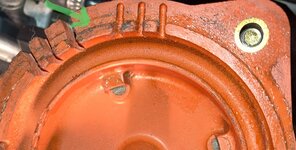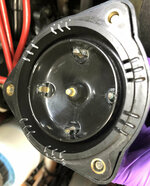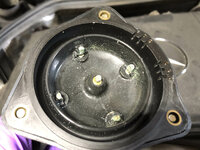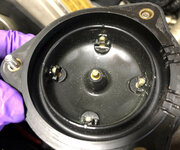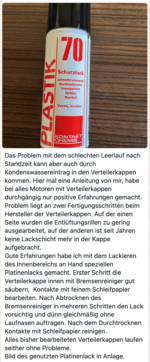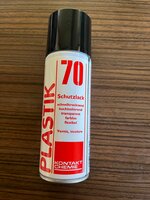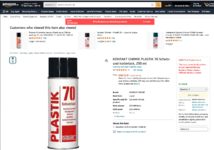One of my cars received new caps, rotors, and insulators along with new oil seals at the cam sprocket behind the rotor bracket. Several years but only 2500 miles later, I discovered the new insulator had a film of liquid on front & back. The insulators are new Bosch aftermarket without the clear coating. This was in the middle of summer with a 100F heat wave and humidity near single digit levels. It wasn't moisture.
But... the oil seals are new and there was NO trace of oil around the seal. HOWEVER! The cam solenoid/magnets have a slight leak (from the metal body, and/or the electrical connector). And there was a trace of engine oil running along the edge of the front head cover, at a ~45° angle, where the oil runs along the bottom edge of the distributor. The liquid on the insulator could not be water or moisture, and was definitely not oil vapor leaking past old radial seals. Also, there was oil at the lower edge of the distributor cap, near the bottom venting slots.
Latest update on
post #132 above:
The car referenced above was driving normally 99% of the time since the work performed in Sept-2021. This spring when fired up after 7 months of storage, it ran normally for a 25-minute test drive. But when parked for maybe 10 mins, after a restart it began misfiring.
For reference:
- Caps are Beru, 9 years old, but only 5kmi. NO vent slots cut.
- Insulators are Bosch, 9 years old, but only 5kmi. Visually perfect.
- Rotors are OE Doduco, 3 years old, 3kmi. Visually perfect.
I removed both caps for visual inspection. The driver side (left) looked good and was mostly dry. The passenger side (right) had visible moisture in the cap along with visible carbon tracks from arcing / misfiring. Yep, time to add the vent slots. Once again, the insulators had a thin film of liquid (NOT water) covering both front & rear surfaces. The aluminum head cover behind the insulator is bone dry on both driver & passenger sides. Since the cam solenoids were original and not replaced or resealed, there was still the small amount of engine oil present at the lower edge of the caps.
So, I installed re-sealed cam solenoids/magnets per
@JC220's writeup (
click here). Disassembled, cleaned, de-oiled, and reassembled the magnets with
Permatex Ultra Black RTV (the super-oil-resistant stuff). Hopefully this will eliminate the trace of engine oil which keeps reappearing at the lower edge of the distributor cap. The cam magnets were installed with anaerobic sealant per the FSM. The head surfaces surrounding the cam magnets and distributors were carefully degreased to help identify any oil leaks in the future. It's all clean & dry right now.
The passenger cap looked pretty bad, but cleaned up nicely, as did the driver side. I cut the vent slots (per
this thread) to improve ventilation and hopefully eliminate the misfiring due to water/condensation buildup 20-30 mins after a cold start. The rotors were fine and reinstalled as-is. The insulators had the film of unknown liquid wiped off with solvent and reinstalled.
I'm hoping this will cure the occasional misfiring permanently, assuming the engine oil leaks are 100% stopped. The added ventilation should prevent water/condensation from building up inside the cap, and the lack of engine oil should prevent the weird film building up on the insulator. I plan to take everything apart next winter while in storage (after a summer of driving/racing) to see if the insulators are still nice & dry, then monitor yearly after that.
I did pretty much the same thing on a different car (cut vent slots in the caps, eliminated oil leaks with new cam magnets, etc etc - photos
here) and will monitor that engine as well. This is the first time I've replaced or resealed the cam magnets and I'm really hoping it will be the permanent fix for both cars. I also plan to re-seal more cam magnets and do the same job on other cars, it's just a PITA because the power steering reservoir has to come off to do this job.
Photos below, before & after. Note the engine oil visible at the bottom of the cap (at the vent slots) in the "Before" pictures.
 UPDATE: At the end of the 2024 race season, there have been zero issues with misfiring. I'll continue to update over time to see how long the "fix" will last.
UPDATE: At the end of the 2024 race season, there have been zero issues with misfiring. I'll continue to update over time to see how long the "fix" will last.


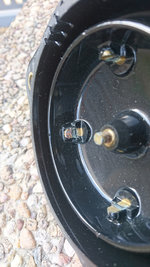




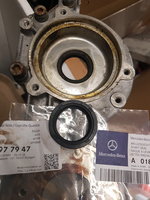
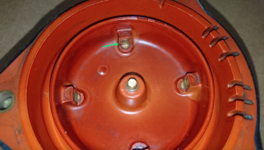
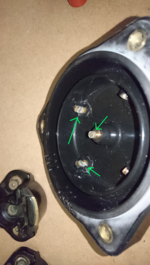
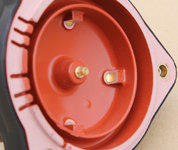
![[500Eboard] bosch_cap5.jpg](/forums/data/attachments/105/105599-d4068d496c0d9b522f1c826bb76d16c9.jpg?hash=1AaNSWwNm1)





